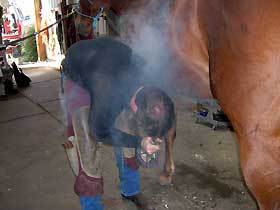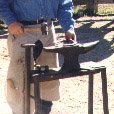Horse Shoes
Horse Shoes protect the horse's foot from excessive wear and resulting tenderness.
Other Benefits:
They provide traction when necessary for safety and/or speed on slippery surfaces much like winter tires for a car.
Shoes correct or influence the stance and/or gait of the horse.
(The Tennessee Walking horse picks his feet high up off the ground due to the kind of shoe it wears).
Specially made shoes correct or improve "abnormalities of the feet.
Horse Shoes -
Hot VS Cold Shoeing
I am listing some terms used in fitting horse shoes.
Hot shaping refers to shoe bending or cutting procedures with the use of heat. (forge)
Cold shaping involves shoe bending or cutting without the use of heat.
Cold fitting is best described as the process of "hammer-leveling" a horseshoe and "rasp-leveling" a horse's hoof to create a union between each.
Hot Fitting or often times referred to as "scorching" is a result of using the heat of the shoe to create a union by directly imprinting it on the hoof, immediately after removing it from the fire..Over-burning a thin, sensitive sole could cause severe pain and may require several weeks or even months of stall rest.
Those who practice hot shoeing, first heat the shoe until it is very hot, then mold it and pound it on an anvil until it's shaped like the hoof.
They have to make the nail holes in the shoe themselves, and then they have to cool the horse shoes in water or on the ground before they put it on the hoof.

Hot shoeing is not for every horse. It is also more expensive. The alternative is cold shoeing. The farriers take regular shoes and set them against the hoof. Then they will put the shoe on an anvil, and use a heavy hammer to shape the shoe to the horse's hoof. Then the hoof will be nailed to the shoe.
Which Method is Better
When it comes to hoof care and shoeing: There are varying opinions. But the consensus is that hot shoeing is a better fit for the horse.
It is more expensive and time consuming and not all horses are capable of being hot shod. Some panic thinking they will get burnt.
Here is an experts opinion: The same expert: 2 different opinions
A hot-fit shoe is more stable than one cold-fit because, assuming it's nailed on where it was fit, the wall is an exact mirror image of the shoe." Tom Stovall, CJF
"Cold shoeing is my method of choice because cold shoeing is easier and much faster". Tom Stovall, CJF

Here is a farrier using an anvil to shape the horse shoe.
Finding the Right Blacksmith
Every horse owner will need a blacksmith. So here are some places to look:
You could call your vet.
Tack shops and feed stores often have a bulletin board with all sorts of animal ads and stuff. Usually there will be some farrier's business cards tacked up.
Ask a friend who has horses and knows about hoof care
If you board your horse, ask the boarding stable owner.
If you have no friends, no neighbors and no vet. Then try the local phone book.
Signs of a Good Farrier
Get a farrier that went to farrier school, or studied the science. He's bound to know more and do a better job than the guy that taught himself.
See how he behaves around horses. He should be calm, and have a confident attitude but not be rough or hit the horse
AND MOST IMPORTANT...he should be able to put shoes on correctly!
Types of Shoes
There are different types of shoes available with different weights, sizes, and shapes.
Regular shoes work great, and are probably all that you will need.
Special shoes are only needed for horses with problems or horses that compete in some events.
For example:
Tennessee Walkers need a special shoe that is really thick and weight a lot in order to make them step high.
Reining horses need hind shoes that have just a little bit of shoe sticking out behind the heel, to help them do smooth sliding stops.
Racehorses need really light shoes so that they can run faster.
Barrel Racing horses need light shoes like racehorses to help them to go faster. Some, if they have trouble getting a grip, wear shoes that are light but keep the horse from slipping.
Horses recovering from laminitis (founder) may need special shoes to support their weight & keep pressure off of the coffin bone.
Move From Horse Shoes Back To General Horse Care.
Move Back To Living With Horses Home Page
Products
|
|
|

